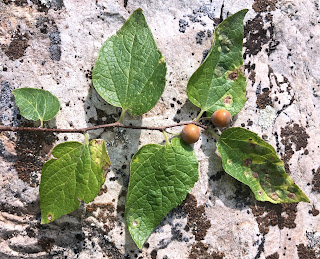 |
| Celtis Reticulata |
 |
| Hackberries (closeup of split seed and fruit) |
The fresh, ripe berries are orange, round, less than a centimeter wide, and grow from the axils of the leaves. They have a large seed with a thin layer of yellow fruit. The seed has a hard brown shell, and a white kernel. At this stage they have a fresh, sweet taste which is mildly reminiscent of apricot.
The berries persist on the tree in the winter and even through the next year, so they can be a source of food in winter and in the early spring. They remain edible all winter because, as Samuel Thayer notes, they are high in sugar and low in water, and also, as noted below, the fruit flesh is resistant to bacteria and fungus infestations. The older berries have a red skin, and persist on twigs without leaves, or with leaves which are old and dry. The fruit dries to a leathery but soft texture, not hard and dry. The old berries are still edible but the taste intensifies. Others who tried it said it tasted sort of like an apricot fruit leather. I thought it tasted like honey-flavored fruit leather, just not nearly as sweet as honey.
The seed is also edible, but the hard shell can be difficult to bite into, especially in old berries. Using a mortar and pestle, two rocks, the flat of a knife, or other grinding appliance is helpful for eating the full berry. This is worth it if you are doing more than just tasting, because the kernel is high in protein and fat, even though it has little flavor. Smashing the fruit and grinding it into a paste gives you a palatable, if rather crunchy, meal.
But a better option for getting the nutrition from this hard seed is to crush it and mix it with water to make "hackberry milk", which is similar to other nut-milks, such as almond milk or cashew milk, but has its own mildly sweet flavor. For convenience, I use a blender, and blend 1 part hackberries with 4 parts water, then strain. The result is a thickish liquid (like milk) which tastes like drinking liquid hackberries. One excellent use for hackberry milk is as a base liquid for Thai Curry (instead of coconut milk). Just mix one tablespoon of red curry paste in 2-4 cups of hackberry milk, and add to your cooked meat and vegetables.
 |
| Tree in winter, with dried leaves and fruits |
No comments:
Post a Comment